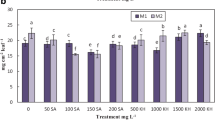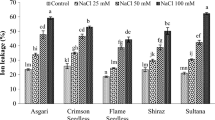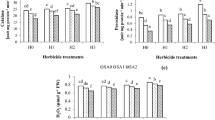Abstract
Sulforaphene is an isothiocyanate which is produced by the hydrolysis from glucoraphenin, one of glucosinolates mostly found in radish plant. This study evaluates the genetic diversity of sulforaphene contents from the seedlings of 29 radish genotypes in an attempt to find a variety with a high extraction yield and which can be used as a breeding source of intergeneric hybrid vegetable Baemuchae. The sulforaphene content was highest in the seedlings of ‘Cheongwoonplus’ (1,426.8 mg kg− 1 FW) and ‘Taebaek’ (1,363.3 mg kg− 1 FW) cultivars and lowest in the ‘Matchuimbom’ (328.7 mg kg− 1 FW) cultivar. The sulforaphene contents of four radish cultivars and three Baemuchae varieties sharply decreased during seedling growth; however, they were much higher in the seedlings of radish cultivars than in Baemuchae varieties. The sulforaphene contents in unpollinated pistil tissues were not affected by species, whereas they responded differently to the cultivar or variety. After pollination, the sulforaphene content gradually increased in radish cultivars during seed development, but relatively much less in Baemuchae varieties. These results indicated that the sulforaphene content varied widely in the seedlings of radish cultivars. Sulforaphene gradually accumulated after pollination during seed development in radish cultivars, but not much in Baemuchae varieties. However, not much difference was observed in the sulforaphene contents of unpollinated pistil tissues of radish and baemoochae.





Similar content being viewed by others
References
Agneta R, Lelario F, De Maria S, Möllers C, Bufo SA, Rivelli AR (2014) Glucosinolate profile and distribution among plant tissues and phenological stages of field-grown horseradish. Phytochemistry 106:178–187. https://doi.org/10.1016/j.phytochem.2014.06.019
Barillari J, Cervellati R, Paolini M, Tatibouët A, Rollin P, Iori R (2005) Isolation of 4-methylthio-3-butenyl glucosinolate from Raphanus sativus sprouts (kaiware daikon) and its redox properties. J Agric Food Chem 53:9890–9896. https://doi.org/10.1021/jf051465h
Bertelli D, Plessi M, Braghiroli D, Monzani A (1998) Separation by solid phase extraction and quantification by reverse phase HPLC of sulforaphane in broccoli. Food Chem 63:417–421. https://doi.org/10.1016/S0308-8146(98)00052-1
Bhandari SR, Jo JS, Lee JG (2015) Comparison of glucosinolate profiles in different tissues of nine Brassica crops. Molecules 20:15827–15841. https://doi.org/10.3390/molecules200915827
Blažević I, Montaut S, Burčul F, Olsen CE, Burow M, Rollin P, Agerbirk N (2020) Glucosinolate structural diversity, identification, chemical synthesis and metabolism in plants. Phytochemistry 169:112100. https://doi.org/10.1016/j.phytochem.2019.112100
Bones AM, Rossiter JT (1996) The myrosinase-glucosinolate system, its organisation and biochemistry. Physiol Plant 97:194–208. https://doi.org/10.1111/j.1399-3054.1996.tb00497.x
Brown AF, Yousef GG, Jeffery EH, Klein BP, Wallig MA, Kushad MM, Juvik JA (2002) Glucosinolate profiles in broccoli: variation in levels and implications in breeding for cancer chemoprotection. J Amer Soc Hortic Sci 127:807–813. https://doi.org/10.21273/JASHS.127.5.807
Brown PD, Tokuhisa JG, Reichelt M, Gershenzon J (2003) Variation of glucosinolate accumulation among different organs and developmental stages of Arabidopsis thaliana. Phytochemistry 62:471–481. https://doi.org/10.1016/S0031-9422(02)00549-6
Cartea ME, Velasco P (2008) Glucosinolates in Brassica foods: bioavailability in food and significance for human health. Phytochem Rev 7:213–229. https://doi.org/10.1007/s11101-007-9072-2
Castillejo N, Martínez-Zamora L, Artés-Hernández F (2022) Postharvest UV radiation enhanced biosynthesis of flavonoids and carotenes in bell peppers. Postharvest Biol Technol 184:111774. https://doi.org/10.1016/j.postharvbio.2021.111774
Chen S, Andreasson E (2001) Update on glucosinolate metabolism and transport. Plant Physiol Biochem 39:743–758. https://doi.org/10.1016/S0981-9428(01)01301-8
Ciska E, Martyniak-Przybyszewska B, Kozlowska H (2000) Content of glucosinolates in cruciferous vegetables grown at the same site for two years under different climatic conditions. J Agric Food Chem 48:2862–2867. https://doi.org/10.1021/jf981373a
Clossais-Besnard N, Larher F (1991) Physiological role of glucosinolates in Brassica napus. Concentration and distribution pattern of glucosinolates among plant organs during a complete life cycle. J Sci Food Agric 56:25–38. https://doi.org/10.1002/jsfa.2740560104
Dandurand L-M, Mosher RD, Knudsen GR (2000) Combined effects of Brassica napus seed meal and Trichoderma harzianum on two soilborne plant pathogens. Can J Microbiol 46:1051–1057. https://doi.org/10.1139/w00-087
Ellerbrock BLJ, Kim JH, Jander G (2007) Contribution of glucosinolate transport to Arabidopsis defense responses. Plant Signal Behav 2:282–283. https://doi.org/10.4161/psb.2.4.4014
Fahey JW, Zalcmann AT, Talalay P (2001) The chemical diversity and distribution of glucosinolates and isothiocyanates among plants. Phytochemistry 56:5–51. https://doi.org/10.1016/S0031-9422(00)00316-2
Farnham MW, Wilson PE, Stephenson KK, Fahey JW (2004) Genetic and environmental effects on glucosinolate content and chemoprotective potency of broccoli. Plant Breed 123:60–65. https://doi.org/10.1046/j.0179-9541.2003.00912.x
Fenwick GR, Heaney RK, Mullin WJ, VanEtten CH (1983) Glucosinolates and their breakdown products in food and food plants. Crit Rev Food Sci Nutr 18:123–201. https://doi.org/10.1080/10408398209527361
Gantait S, Mukherjee E (2021) Induced autopolyploidy—a promising approach for enhanced biosynthesis of plant secondary metabolites: an insight. J Genet Eng Biotechnol 19:4. https://doi.org/10.1186/s43141-020-00109-8
Guo L, Yang R, Wang Z, Guo Q, Gu Z (2014) Glucoraphanin, sulforaphane and myrosinase activity in germinating broccoli sprouts as affected by growth temperature and plant organs. J Funct Foods 9:70–77. https://doi.org/10.1016/j.jff.2014.04.015
Han N, Ku KM, Kim J (2019) Postharvest variation of major glucosinolate and their hydrolytic products in Brassicoraphanus ‘BB1’. Postharvest Biol Technol 154:70–78. https://doi.org/10.1016/j.postharvbio.2019.04.011
Han N, Lee J, Kim J (2022) Comparative responses of glucosinolates in Baemoochae and its parent plants, radish and chinese cabbage, during development. Sci Hortic 295:110870. https://doi.org/10.1016/j.scienta.2021.110870
Hong E, Kim G-H (2014) Variation of glucosinolate composition during seedling and growth stages of Brassica rapa L. ssp. pekinensis. Kor J Hortic Sci Technol 32:730–738. https://doi.org/10.7235/hort.2014.14041
Hong E, Kim S-J, Kim G-H (2011) Identification and quantitative determination of glucosinolates in seeds and edible parts of korean chinese cabbage. Food Chem 128:1115–1120. https://doi.org/10.1016/j.foodchem.2010.11.102
Iori R, Barillari J, Gallienne E, Bilardo C, Tatibouët A, Rollin P (2008) Thio-functionalised glucosinolates: unexpected transformation of desulfoglucoraphenin. Tetrahedron Lett 49:292–295. https://doi.org/10.1016/j.tetlet.2007.11.059
Isah T (2019) Stress and defense responses in plant secondary metabolites production. Biol Res 52:39. https://doi.org/10.1186/s40659-019-0246-3
Jeon BW, Oh M-H, Kim HS, Kim EO, Chae WB (2022) Glucosinolate variation among organs, growth stages and seasons suggests its dominant accumulation in sexual over asexual-reproductive organs in white radish. Sci Hortic 291:110617. https://doi.org/10.1016/j.scienta.2021.110617
Jurić S, Sopko Stracenski K, Król-Kilińska Ż, Žutić I, Uher SF, Đermić E, Topolovec-Pintarić S, Vinceković M (2020) The enhancement of plant secondary metabolites content in Lactuca sativa L. by encapsulated bioactive agents. Sci Rep 10:3737. https://doi.org/10.1038/s41598-020-60690-3
Kakizaki T, Kitashiba H, Zou Z, Li F, Fukino N, Ohara T, Nishio T, Ishida M (2017) A 2-oxoglutarate-dependent dioxygenase mediates the biosynthesis of glucoraphasatin in radish. Plant Physiol 173:1583–1593. https://doi.org/10.1104/pp.16.01814
Kim JK, Chu SM, Kim SJ, Lee DJ, Lee SY, Lim SH, Ha S-H, Kweon SJ, Cho HS (2010) Variation of glucosinolates in vegetable crops of Brassica rapa L. ssp. pekinensis Food Chem 119:423–428. https://doi.org/10.1016/j.foodchem.2009.08.051
Kliebenstein DJ, Kroymann J, Brown P, Figuth A, Pedersen D, Gershenzon J, Mitchell-Olds T (2001) Genetic control of natural variation in Arabidopsis glucosinolate accumulation. Plant Physiol 126:811–825. https://doi.org/10.1104/pp.126.2.811
Lee SS, Choi WJ, Woo JG (2002) Development of a new vegetable crop in xBrassicoraphanus by hybridization of Brassica campestris and Raphanus sativus. J Kor Soc Hortic Sci 43:693–698
Lee JG, Lim S, Kim J, Lee EJ (2017) The mechanism of deterioration of the glucosinolate-myrosynase system in radish roots during cold storage after harvest. Food Chem 233:60–68. https://doi.org/10.1016/j.foodchem.2017.04.104
Lee S, Kim J, Lee J (2021) Differential glucosinolate profiles of radish leaves in response to postharvest drying treatment. Hortic Environ Biotechnol 62:581–592. https://doi.org/10.1007/s13580-021-00345-y
Lim S, Lee J, Kim J-K (2009) Analysis of isothiocyanates in newly generated vegetables, Baemuchae (×Brassicoraphanus) as affected by growth. Int J Food Sci Technol 44:1401–1407. https://doi.org/10.1111/j.1365-2621.2009.01970.x
Lim S, Lee EJ, Kim J (2015) Decreased sulforaphene concentration and reduced myrosinase activity of radish (Raphanus sativus L.) root during cold storage. Postharvest Biol Technol 100:219–225. https://doi.org/10.1016/j.postharvbio.2014.10.007
Lim S, Han S-W, Kim J (2016) Sulforaphene identified from radish (Raphanus sativus L.) seeds possesses antimicrobial properties against multidrug-resistant bacteria and methicillin-resistant Staphylococcus aureus. J Funct Foods 24:131–141. https://doi.org/10.1016/j.jff.2016.04.005
López-Cervantes J, Tirado-Noriega LG, Sánchez-Machado DI, Campas-Baypoli ON, Cantú-Soto EU, Núñez-Gastélum JA (2013) Biochemical composition of broccoli seeds and sprouts at different stages of seedling development. Int J Food Sci Technol 48:2267–2275. https://doi.org/10.1111/ijfs.12213
Lv X, Meng G, Li W, Fan D, Wang X, Espinoza-Pinochet CA, Cespedes-Acuña CL (2020) Sulforaphane and its antioxidative effects in broccoli seeds and sprouts of different cultivars. Food Chem 316:126216. https://doi.org/10.1016/j.foodchem.2020.126216
Malik MS, Riley MB, Norsworthy JK, Bridges W (2010) Glucosinolate profile variation of growth stages of wild radish (Raphanus raphanistrum). J Agric Food Chem 58:3309–3315. https://doi.org/10.1021/jf100258c
Mok S-Y, Choi MJ, Kim J, Cho EJ, Lee S (2012) Antioxidant activity of the methanolic extract of the newly generated vegetable, baemuchae (xBrassicoraphanus). Food Chem Toxicol 50:848–853. https://doi.org/10.1016/j.fct.2012.01.006
Nakagawa K, Umeda T, Higuchi O, Tsuzuki T, Suzuki T, Miyazawa T (2006) Evaporative light-scattering analysis of sulforaphane in broccoli samples: quality of broccoli products regarding sulforaphane contents. J Agric Food Chem 54:2479–2483. https://doi.org/10.1021/jf051823g
Njumbe Ediage E, Diana Di Mavungu J, Scippo ML, Schneider YJ, Larondelle Y, Callebaut A, Robbens J, Van Peteghem C, De Saeger S (2011) Screening, identification and quantification of glucosinolates in black radish (Raphanus sativus L. niger) based dietary supplements using liquid chromatography coupled with a photodiode array and liquid chromatography - mass spectrometry. J Chromatogr A 1218:4395–4405. https://doi.org/10.1016/j.chroma.2011.05.012
Nour-Eldin HH, Andersen TG, Burow M, Madsen SR, Jørgensen ME, Olsen CE, Dreyer I, Hedrich R, Geiger D, Halkier BA (2012) NRT/PTR transporters are essential for translocation of glucosinolate defence compounds to seeds. Nature 488:531–534. https://doi.org/10.1038/nature11285
Pannu N, Bhatnagar A (2019) Resveratrol: from enhanced biosynthesis and bioavailability to multitargeting chronic diseases. Biomed Pharmacother 109:2237–2251. https://doi.org/10.1016/j.biopha.2018.11.075
Petersen B, Chen S, Hansen C, Olsen C, Halkier B (2002) Composition and content of glucosinolates in developing Arabidopsis thaliana. Planta 214:562–571. https://doi.org/10.1007/s004250100659
Rangkadilok N, Tomkins B, Nicolas ME, Premier RR, Bennett RN, Eagling DR, Taylor PWJ (2002) The effect of postharvest and packaging treatments on glucoraphanin concentration in broccoli (Brassica oleracea var. italica). J Agric Food Chem 50:7386–7391. https://doi.org/10.1021/jf0203592
Rosa EAS, Heaney RK, Portas CAM, Fenwick GR (1996) Changes in glucosinolate concentrations in Brassica crops (B. oleracea and B. napus) throughout growing seasons. J Sci Food Agric 71:237–244. https://doi.org/10.1002/(SICI)1097-0010(199606)71:2<237::AID-JSFA574>3.0.CO;2-P
Sang JP, Minchinton IR, Johnstone PK, Truscott RJW (1984) Glucosinolate profiles in the seed, root and leaf tissue of cabbage, mustard, rapeseed, radish and swede. Can J Plant Sci 64:77–93. https://doi.org/10.4141/cjps84-011
Shapiro TA, Fahey JW, Wade KL, Stephenson KK, Talalay P (2001) Chemoprotective glucosinolates and isothiocyanates of broccoli sprouts: metabolism and excretion in humans. Cancer Epidemiol Biomarkers Prev 10:501–508
Shishu, Kaur IP (2009) Inhibition of cooked food-induced mutagenesis by dietary constituents: comparison of two natural isothiocyanates. Food Chem 112:977–981. https://doi.org/10.1016/j.foodchem.2008.07.019
Sønderby IE, Geu-Flores F, Halkier BA (2010) Biosynthesis of glucosinolates - gene discovery and beyond. Trends Plant Sci 15:283–290. https://doi.org/10.1016/j.tplants.2010.02.005
Songsak T, Lockwood GB (2002) Glucosinolates of seven medicinal plants from Thailand. Fitoterapia 73:209–216. https://doi.org/10.1016/S0367-326X(02)00061-8
Thakur M, Bhattacharya S, Khosla PK, Puri S (2019) Improving production of plant secondary metabolites through biotic and abiotic elicitation. J Appl Res Med Aromat Plants 12:1–12. https://doi.org/10.1016/j.jarmap.2018.11.004
Tiwari R, Rana C (2015) Plant secondary metabolites: a review. Int J Engin Res Gen Sci 3:661–670
Vierheilig H, Ocampo J (1990) Effect of isothiocyanates on germination of spores of G. mosseae. Soil Biol Biochem 22:1161–1162
Yi G, Lim S, Chae WB, Park JE, Park HR, Lee EJ, Huh JH (2016) Root glucosinolate profiles for screening of radish (Raphanus sativus L.) genetic resources. J Agric Food Chem 64:61–70. https://doi.org/10.1021/acs.jafc.5b04575
Zhao Y, Chen Z, Chen J, Chen B, Tang W, Chen X, Lai Z, Guo R (2021) Comparative transcriptomic analyses of glucosinolate metabolic genes during the formation of chinese kale seeds. BMC Plant Biol 21:394. https://doi.org/10.1186/s12870-021-03168-2
Acknowledgements
The authors thank Prof. Dr. Soo-Seong Lee for his support of providing the baemoochae seeds used in this study.
Author information
Authors and Affiliations
Contributions
Jinhee Lee: Data curation, Formal analysis, Investigation, Methodology, Writing, Revision. Jongkee Kim: Conceptualization, Data curation, Formal analysis, Investigation, Writing - Reviewing and Editing. Jinwook Lee: Data curation, Investigation, Writing - Revision and Editing.
Corresponding author
Ethics declarations
Competing interest
There are no competing interests to declare.
Additional information
Communicated by Eun Jin Lee.
Publisher’s Note
Springer Nature remains neutral with regard to jurisdictional claims in published maps and institutional affiliations.
Rights and permissions
Springer Nature or its licensor (e.g. a society or other partner) holds exclusive rights to this article under a publishing agreement with the author(s) or other rightsholder(s); author self-archiving of the accepted manuscript version of this article is solely governed by the terms of such publishing agreement and applicable law.
About this article
Cite this article
Lee, J., Kim, J. & Lee, J. Comparative responses of sulforaphene contents between radish (Raphanus sativus L.) and Baemuchae (xBrassicoraphanus) during seed development. Hortic. Environ. Biotechnol. 64, 895–903 (2023). https://doi.org/10.1007/s13580-023-00534-x
Received:
Accepted:
Published:
Issue Date:
DOI: https://doi.org/10.1007/s13580-023-00534-x




